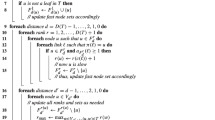Abstract
This paper studies the performance of various strategies for scheduling a combined load of unicast and multicast traffic in a broadcast WDM network. The performance measure of interest is schedule length, which directly affects both aggregate network throughput and average packet delay. Three different scheduling strategies are presented, namely: separate scheduling of unicast and multicast traffic, treating multicast traffic as a number of unicast messages, and treating unicast traffic as multicasts of size one. A lower bound on the schedule length for each strategy is first obtained. Subsequently, the strategies are compared against each other using extensive simulation experiments in order to establish the regions of operation, in terms of a number of relevant system parameters, for which each strategy performs best. Our main conclusions are as follows. Multicast traffic can be treated as unicast traffic, by replicating all multicast packets, under very limited circumstances. On the other hand, treating unicast traffic as a special case of multicast traffic with a group of size 1, produces short schedules in most cases. Alternatively, scheduling and transmitting each traffic component separately is also a good choice.
Similar content being viewed by others
References
M. Ammar, G. Polyzos, S. Tripathi (eds.), Special issue on network support for multipoint communication, IEEE Journal Selected Areas in Communications, vol. 15, no. 3, (April 1997).
M. Azizoglu, R. A. Barry, A. Mokhtar, Impact of Tuning Delay on the Performance of Bandwidth-limited Optical Broadcast Networks with Uniform Traffic, IEEE Journal on Selected Areas in Communications, vol. 14, no. 5, (June 1996), pp. 935–944.
M. Borella, B. Mukherjee, A Reservation-based Multicasting Protocol for WDM Local Lightwave Networks, Proc. of ICC '95 (Seattle, Washington, June 1995), pp. 1277–1281.
M. S. Borella, B. Mukherjee, Efficient Scheduling of Nonuniform Packet Traffic in a WDM/TDM Local Lightwave Network with Arbitrary Transceiver Tuning Latencies, IEEE Journal on Selected Areas in Communications, vol. 14, no. 5 (June 1996), pp. 923–934.
Z. Ortiz, G. N. Rouskas, H. G. Perros, Scheduling of multicast traffic in tunable-receiver WDM networks with nonnegligible tuning latencies, Proc. of SIGCOMM '97 (Cannes, France, Sept. 1997) pp. 301–310.
G. R. Pieris, G. H. Sasaki, Scheduling Transmissions in WDM Broadcast-and-Select Networks, IEEE/ACM Transactions on Networking, vol. 2, no. 2 (April 1994), pp. 105–110.
G. N. Rouskas, M. H. Ammar, Multi-destination Communication Over Tunable-receiver Single-hop WDM Networks, IEEE Journal on Selected Areas in Communications, vol. 15, no. 3 (April 1997), pp. 501–511.
G. N. Rouskas, V. Sivaraman, Packet Scheduling in Broadcast WDM Networks with Arbitrary Transceiver Tuning Latencies, IEEE/ACM Transactions on Networking, vol. 5, no. 3 (June 1997), pp. 359–370.
V. Sivaraman, G. N. Rouskas, HiPeR-ℓ: A High Performance Reservation Protocol with ℓook-ahead for broadcast WDM networks, Proc. of INFOCOM '97 (Kobe, Japan, March 1997), pp. 1272–1279.
Author information
Authors and Affiliations
Rights and permissions
About this article
Cite this article
Ortiz, Z., Rouskas, G.N. & Perros, H.G. Scheduling Combined Unicast and Multicast Traffic in Broadcast WDM Networks. Photonic Network Communications 2, 135–153 (2000). https://doi.org/10.1023/A:1010084306132
Issue Date:
DOI: https://doi.org/10.1023/A:1010084306132




